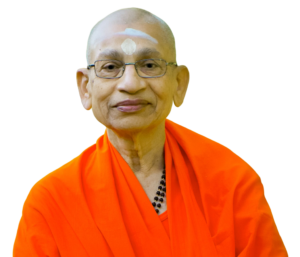
Spiritual Discourses: Īśvara is One Limitless Self
By Swami Viditatmananda Saraswati
Na Me Bhaktaḥ Praṇaśyati – 04
Īśvara is One Limitless Self. Īśvara is the creator, sustainer, and resolver.
Na me bhaktaḥ praṇaśyati, my devotee never suffers a decline. In this statement, “my devotee” refers to a devotee of the Lord, īśvara. When Lord Krishna says “I,” he means the Lord, īśvara. The nature of īśvara is the one, nondual, ultimate reality, which is the ultimate reality of ourselves, of the universe, and of the creator. Nondual means that it is not limited by any other thing, so it is limitless. The whole and complete is the one reality of life that alone pervades as the self of each individual and the universe, as well as the creator. That is what is meant by īśvara. As Lord Krishna says, “There is nothing other than me.” Īśvara is generally looked upon as the creator, as the cause of the creation. Lord Krishna says, “ahaṁ sarvasya prabhavo mattaḥ sarvaṁ pravartate, I am the origin and the source of everything, and from me alone, everything is impelled.” That means “I am the very motivating force behind all the activities. I am the one who is the source of creation and I am the one who is the force behind the dynamism of creation. I provide the sattā, the existence, as well as the intelligence, as well as the dynamism to the whole creation.” That limitless īśvara is the creator as well as the sustainer and the resolver. In the ultimate sense when we say that īśvara, the ultimate reality, is “limitless, complete, whole,” it really means that īśvara is devoid of all attributes. Īśvara is the one who possesses all the attributes and simultaneously the one who transcends all the attributes. This is our understanding of īśvara.
But there are those who say that īśvara is only formless, only in heaven, only the transcendent reality. The question we Vedāntins ask them is, “If īśvara is only formless, then where do the forms come from?” They say that īśvara created the forms, so then the question is, “From what did he create?” They say that he created from something other than himself. That means there is duality, which does not make sense. Therefore, the Vedas teach us that īśvara is formless, attributeless, and limitless and, at the same time, he manifests as all the forms and all the attributes. He is without form or attributes or limits, while at the same time, he alone manifests as all the forms, all the attributes.
An actor pervades and transcends the roles
To understand this transcendence, consider the example of an actor, who can take any role. One actor can be a saint, a sinner, a king, a minister, or a beggar, while at the same time, he is not any of those things, meaning that he transcends all those roles. The actor is not a beggar, a king, or a minister, and yet the same actor manifests as the beggar, king, and minister. How is it possible that one entity is the king and beggar, saint and sinner? This can only happen when he is neither a saint nor a sinner, not a king nor a beggar. The actor pervades all the roles and at the same time, he himself transcends all the roles. He pervades all the roles, meaning that the king cannot exist without the actor. The beggar, sinner, saint—any role—cannot be without the actor, but the actor can be without any of those roles. The actor is independent of the roles, while the roles are all dependent on the actor. The actor is essential and the beggar is incidental. Incidental is that which comes and goes. Essential is that which always is. The roles come and go—now king, now beggar—they are all incidental. In all the changes that take place in the roles, the actor is the same; he is changeless. He is essential and the roles are incidental.
The Vedāntin’s explanation of the relationship between the actor and the beggar is that the beggar is superimposed upon the actor. When the actor changes to the role of a king, the king is superimposed upon the actor. The actor assumes a variety of roles without becoming any role. He does not become a beggar, he simply acts as a beggar. Thus, the beggar is superimposed upon the actor. Vedanta would say that the actor is real and the beggar is unreal. When the actor is on stage acting as a beggar, would you go and hand him a coin? No, because you know that even though he looks like a beggar, he is not really a beggar. He is as though a beggar; thus, we say that the incidental role is a superimposition; it is mithyā, unreal. The mithyā beggar looks like a beggar but is not a real beggar. Because he has studied beggars, the actor might be even more convincing as a beggar than the local beggar on the corner, but even so, he only appears to be a beggar and is not a real beggar. In spite of appearing as a beggar, he does not become a beggar. If he became a poor beggar by taking the role, he would never take that role; whereas in fact, because of taking that role, the actor becomes even richer than before. Thus, we say that the actor transcends the beggar, king, and all the other roles. The actor retains his true form of a wealthy person, even when he is acting as a beggar. The actor pervades the beggar and at the same time transcends the beggar. He pervades the king and at the same time transcends the king. He can afford to be anything because he does not become anything. His role in no way affects him; he remains what he is all the time. Before, during, and after the role, the actor remains the same.
Īśvara pervades and transcends the creation
Vedanta similarly describes God as one who pervades all of creation without becoming anything. To explain this, various Upaniṣads describe that at the beginning of creation, īśvara, the omniscient creator, created “all this.” He created all the countless unique living things, even bed bugs and mosquitos. Having created all these beings, īśvara entered them as the actor entered the costumes of the roles. “Sa eṣa iha praviṣṭa ānakhāgrebhyaḥ, he has entered here up to the tip of the nail.” The whole body-mind-sense complex is insentient by nature. Like electricity causing a light bulb to glow or like the actor giving life to the costume, it is īśvara, consciousness, who is present in all these bodies, making them alive. Thus, īśvara pervades everything and at the same time transcends everything.
If he is in all of us, you might wonder whether that means he is in a thief also. Yes; he is present in everyone—the tiger, lion, thief, terrorist, everyone. There is nobody other than him, but at the same time, he does not become anyone or anything. Just as the actor does not become any role, similarly īśvara does not become the saint or the sinner. The same īśvara who is present in you is present in all beings, including the thief, because īśvara transcends the roles. He is unaffected by the roles. He appears as the thief but has not become the thief. He appears as each of us but he has not become any of us. Therefore, we can say that what is, is nothing but īśvara. All this is appearance and superimposition. What is real is one īśvara. That one is unaffected by the appearance of many, just as the one actor remains unaffected by taking the appearance of many roles. In Vedanta, appearance is called mithyā, unreal. Īśvara is satyam, real, and all these appearances are mithyā, unreal.
Ignorance causes individuality and limitation
Now, this question might arise: “If everything is īśvara, then who is worshipping whom?” Up to now, we have not thought or felt like we are īśvara. We have assumed that we worship īśvara who is other than us. But now, if it is true that īśvara created all these various costumes, and bodies, and entered into them, then we wonder who is worshipping whom. Is īśvara worshipping īśvara? Is īśvara the devotee of īśvara?
To understand the relationship between the individual and īśvara, imagine an actor who drank too much alcohol to calm his nerves before performing as a beggar. Because of the alcohol, when he enters the costume of the beggar and goes onto the stage, he becomes confused and identifies with the beggar. He forgets that he is a rich man and thinks that he actually is a beggar. Giving up his own identity, he identifies as someone else. Similarly, īśvara, the limitless, has entered into the costume of the body and due to māyā, ignorance, he thinks that “I am an individual being.” That is what we call the jīva, the individual. There is no jīva separate from īśvara, but īśvara identified with a body takes itself to be an individual being and is called a jīva. Bṛhadāraṇyaka Upaniṣad describes that when īśvara identifies with the organ of speech, he becomes the speaker. When he identifies with the organ of seeing, he becomes the seer. Similarly, he becomes a hearer, thinker, talker, walker, and eater. The same one plays all these varieties of roles, not realizing that these are all roles. There was one entity and now there seem to be two entities. One is called īśvara and the other is called jīva. Who are you? You are the one limitless brahman, īśvara, ātmā, thinking that you are “so-and-so,” the jīva. Bhagavān, the Lord, has entered the body and because of the intoxication of māyā, the beginningless ignorance, he no longer remembers his identity. Instead, he thinks “I am only this much, with all the limitations of a physical body and mind.” He is like the wealthy actor who, due to intoxication of alcohol, forgets his identity and thinks, “I am a poor beggar,” and now wants to become wealthy. The wealthy actor becomes a seeker of wealth. Similarly, due to ignorance, limitless īśvara as though “forgets” his true nature and takes himself to be a limited jīva, and then wants to become limitless. The jīva’s nature is limitless, but he becomes a seeker of the limitless.
We place our devotion in the wrong place
We are not looking for happiness where we should be looking. This is not our fault; Bhagavān has done it for us. Kaṭha Upaniṣad says, “parāñci khāni vyatṛṇat svayambhūḥ, īśvara created our mind and senses so they face outward. Tasmāt parāṅpaśyati nāntarātman, therefore, one always looks outside, not within.” The Upaniṣad says that we are programmed such that we always look for what we want outside ourselves. We never look at ourselves. We always look outside for the limitless happiness that we seek, but can never find it where it is not. That is why one becomes a bhakta, a devotee. Who am I? I am a devotee. A devotee of what? A devotee of limitlessness, fullness, completeness. That is īśvara. I am a devotee of īśvara, really. We are all born bhaktas. If I really analyze what it is that I am devoted to, I find that I am devoted to one thing and one thing only, and that is being limitless. But not understanding that I think I want this and I want that, and therefore I am a bhakta of so many things.
Now I am a bhakta of wealth and money, thinking that it will make me free. Now I want a spouse, thinking that will make me free. Now I desire a family, thinking that will make me free. How about grandchildren, maybe they will make me free. All these things are nice to have, but thinking that they will make me free is where the programming is wrong. These things like money and family are not wrong; what is wrong is my thinking that they will make me free. There is something wrong with that conclusion. That conclusion has to be changed. Thus, we are all natural devotees of īśvara, but we are placing our devotion in the wrong place to reach him.
Devotees must know what and where īśvara is
To achieve that limitless happiness that is īśvara, we must first know what īśvara is and where he is. Lord Krishna says, “All that is, is I. I pervade everything and at the same time I transcend everything.” He means that īśvara is both saguṇa, with attributes, and nirguṇa, free of attributes. The idea is that in the ultimate reality, īśvara transcends everything; he is formless, attributeless, nirguṇa. At the same time, all the forms and attributes in the universe are īśvara’s form; he is saguṇa, with attributes. This must be understood. Recall how the actor transcends the roles of king and beggar, while at the same time, he alone is the king and the beggar. In the same way, God, īśvara, transcends everything while at the same time, he alone is everything. Nirguṇa is īśvara and saguṇa also is īśvara. Simultaneously, īśvara is both formless and all forms. How is it possible that īśvara has all the attributes and, at the same time, he is beyond all attributes? It is possible in the same way that the actor can simultaneously be the beggar and beyond the beggar. That is possible only when the beggar is not real. The beggar is a superimposition upon the actor. Similarly, all names and forms and attributes are superimpositions upon īśvara. He appears in all the names and forms but does not become them. He retains his formlessness and limitlessness while appearing to possess all the names and forms.
All this that we see is an appearance of īśvara. What is, is only īśvara, one without a second. When Lord Krishna says “I” he means the one, non-dual and limitless, who simultaneously transcends everything and pervades everything.
(to continue…)
*Swami Viditatmananda Saraswati has been teaching Vedānta Prasthānatrayī and Prakaraṇagranthas for the last 40 years in Ahmedabad, Gujarat. Throughout the year, he conducts daily Vedānta discourses, accompanied by retreats, and Jñāna Yajñas on Vedānta in different cities in India and foreign countries.






